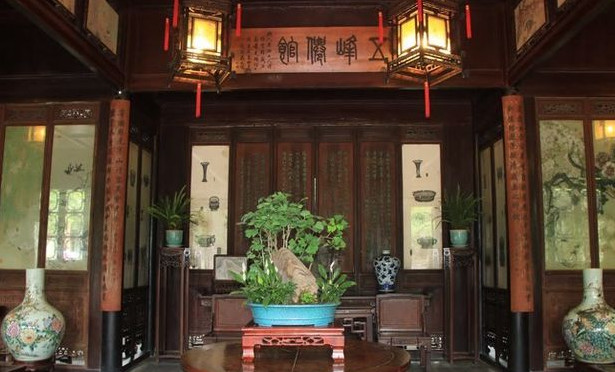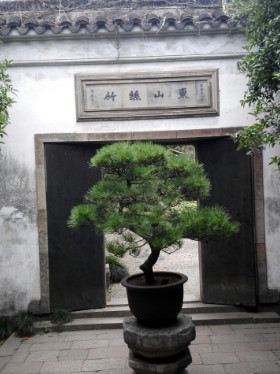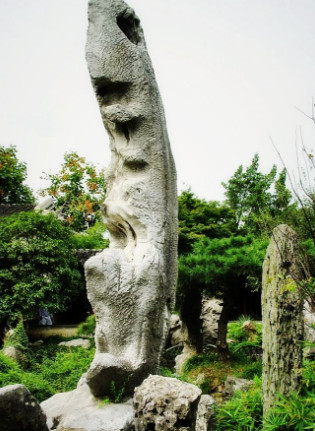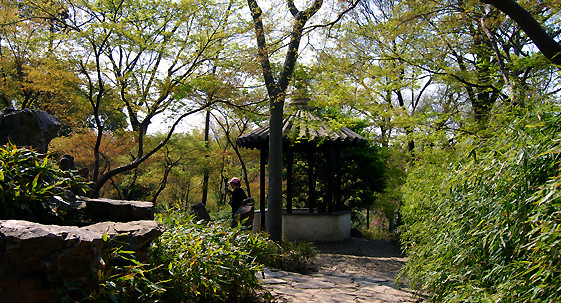Lingering Garden, the crown of the famous gardens in Wuxia (Part 2)
★ Tourist location: Suzhou Lingering Garden
Wufeng Fairy Hall has the reputation of being the first hall in Jiangnan and the largest hall in the park. It has five bays and nine houses. It is built on a hard mountain. The owner of the garden took Li Bai's poem of "Five Old Peaks in the southeast of Lushan Mountain, golden hibiscus is cut out by the blue sky" and moved five rockery to name the five peaks. After continuous construction and transformation by three generations of owners of the Lingering Garden, the foundation of the platform is bluestone, which is said to be a relic of the Ming Dynasty. Wufeng Fairy Hall is the main hall of Sheng's family. The interior is divided into two parts: front and rear. The south is the place for banquets and guests. The flower on the middle round table is the dividing line. On the left is the owner and on the right are the main guests. The inner hall is called the inner hall and is a place to entertain women. The main components of this hall are made of nanmu, so it is also called nanmu hall. There are four marble hanging screens on both sides of the wall, and two marble pieces on the red wooden board, round on the top and square on the bottom. The marble painting screen is like a natural landscape painting, collected in Diancang Mountain, Yunnan Province. The bright moon, breeze, wild mountains and waterfalls are concentrated on a stone surface, which is rare in the country. This painting is called the "Picture of the Sky After Rain". This marble base screen is one of the three treasures of the Lingering Garden that are circulated among the people.
Yifengxuan takes the meaning of Zhu Xi's "bowing to Lushan Mountain in front, and one peak stands alone". It is built on a hard mountain and has two and a half rooms on the outside, but in fact there is only one and a half rooms on the inside. There are piano and chess in the pavilion, and there are chess and Go on the chessboard on the table. There is a lake and stone Duxiu Peak in the west. In front of the pavilion is a small stone forest courtyard, which is 29 meters long from north to south and 15 meters wide from east to west.
Behind it is the master's study and my reading place. It is taken from Tao Yuanming's poem "Reading the Classics of Mountains and Seas","I have cultivated and planted, and I still read my books from time to time." The two-story building is hard on the top of the mountain.
To the east of Yifengxuan is Yuanyang Hall, built by Sheng Family. This is also a famous building in the Lingering Garden and is also common in Suzhou's classical gardens. This kind of building has only one roof when viewed from the outside, but inside it has two roofs and two halls, which are divided into a men's hall and a women's hall. In ancient times, men were superior to women. The one facing south was generally the south hall, which was more gorgeous and decorated with carvings; the one facing north was the women's hall, which was relatively simple in decoration. There is also a place called "Lin Quan Qi Zhi Guan", which means a place where highly respected celebrities gather. The "Praise of Guan Yun Feng" on the screen door is Yu Yue's work. It seems that Mr. Yu and Sheng Kang have a very good relationship, and there are many traces of Yu Yue in the Lingering Garden.
The brick on the Shiku Gate in front of the southern courtyard is the word "Dongshan Silk Bamboo". Dongshan is another name for Xie An. Silk Bamboo refers to music. This is the theater hall of the Sheng family. In ancient times, there were very few types of entertainment activities, and listening to opera was one of the widely popular ones. Most wealthy families basically had this hobby. When they encountered any festive festival, they would invite an opera troupe to come in and sing. In "Dream of the Red Chamber", he even raised a small theater troupe. Of course, even if he also raised his own theater troupe, he would invite an outside theater troupe to sing a new play.
In front of the Yuanyang Hall is Guanyun Peak. Together with Suzhou Ruiyun Peak, Shanghai Jade Linglong Peak, and Hangzhou Wreckle Peak, it is also one of the three treasures of the Lingering Garden. It weighs 5 tons and is 6.5 meters high. It is the highest extant mountain in my country. The unique peak ornamental rockery lake and stone famous peak. Taihu Lake stone is about being thin, wrinkled, leaking and transparent. This stone is all complete, thin and tall. The wrinkles on the stone body are of varying depths. There are caves everywhere, and the sun passes through the stone body obliquely. It is said that this is a relic of the flower stone gang of the Song Dynasty. It was a piece of strange flowers and stones ordered by Emperor Huizong of the Song Dynasty that did not have time to transport. When Sheng Kang moved it at that time, it really took a lot of effort to cross a river and build a bridge.
Xiuyun Peak on the west of Guanyun Peak and Ruiyun Peak on the east were decorated after finding Guanyun Peak. This was also for the occasion. Sheng Xuanhuai named his granddaughter Guanyun, Ruiyun, and Xiuyun respectively. This also shows his love for these three stones. However, the Ruiyun Peak here is not the one of the four major strange stones. Its real body is in Suzhou No. 10 Middle School. Sheng Kang saw this auspicious cloud stone at that time, so he tried every means to find another stone to crown Yunfeng.
There is Huanyun Marsh in front of Guanyun Peak, which is not large in area. To the east is Daiyun Temple, which used to be the home of the Sheng family. Sheng Kang was nicknamed the owner of Daiyun Temple. The nunnery is on the top of a single eaves Xieyuan. It was once called Storage Cloud Nunnery in history, and is now a business place.
Guanyun Tower once had a rather long name when it was in Sheng's house: "Yunmanfeng Head Mantian Building". It has three bays and five rooms, and one and four rooms are connected to each other on the east and west sides. Now it is converted into a teahouse. In the past, our middle school organized an autumn outing to the Lingering Garden. At that time, two other classmates and I had visited the Lingering Garden before, so after walking around with restraint, we drank tea here for an hour and a half and ate the dry food we brought. By the time it was time to gather, we were already exhausted.
The stone on the north wall below is called a fish fossil. It is in a thin sheet shape and peeled off layer by layer like mica. There are more than 20 small fish on it that are lifelike. Even the skulls, vertebrae and ribs are clearly visible. It is really amazing. This is also one of the three treasures of the Lingering Garden.
Guanyun Pavilion has six corners and is decorated with Ruyi oranges on the top. Guanyuntai is actually a pavilion, square in shape and built on a mountain with a single eaves. No matter the buildings, pavilions and platforms, they are all named "Guanyun", which shows that they were all built to admire Guanyun Peak.
Buildings such as Guanyun Tower, Guanyun Pavilion, Guanyun Yuntai, and Daiyun Temple are not tall. This is to highlight the height of Guanyun Peak, so the surrounding buildings are lower than Guanyun Peak.
There is also a pavilion to the west of Huanyun Marsh. The name is very long: "Jiaqing Pavilion for Joy of Rain and Fast Snow". It has a single eaves and a mountain top. It was rebuilt on the basis of the original Shengshi Yiwu Lu after liberation. The name of this pavilion seems to mean that no matter whether it is sunny, rainy, snowy and frost, the scenery of this scenic spot is good. The original pavilion was northwest of the backyard of Wufeng Fairy Hall, and now a row of flower walls has been built.
Walking west from here and passing through a bamboo forest, you can reach the Bonsai Garden, where more than 500 potted bonsai pots are placed. I didn't do my homework in advance when I visited the Lingering Garden in the past. When I went back, the only thing that impressed me the most was Guanyun Peak and the Bonsai Garden. Suzhou bonsai is very famous. It is called Su School bonsai and is a treasure of garden art. Its long history can be traced back to the Tang Dynasty. It began to be famous all over the world during the Ming and Qing Dynasties and became one of the main schools of bonsai in China.
To the north of Bonsai Garden is Xiaotaowu, which has five rooms wide and two ear rooms in front of it. There are many peaches and apricots planted around, but now only green peach leaves can be seen, which are not much ornamental compared with other trees.
From the Bonsai Garden to the south, there is a Zhi Le Pavilion. It was rebuilt after liberation and is modeled on the Imperial Stele Pavilion of Fan Temple on Tianping Mountain. There is a sentence in "Yin Fu Jing" that says,"The greatest joy is the best way to be honest." Wang Youjun likes to grow fruits, saying that there is greatest joy in it. Many fruit trees were planted outside the pavilion in the past, which also inherited this meaning.
On the slope of the west, there is a pavilion called Shuxiao Pavilion, with a round peak. It was called the "Yuexie Star Terrace" in Sheng's days. Tao Yuanming said in his "Return to Lai Ci" that "Climb Donggao to soothe the roar, and write poems near the clear stream." There is indeed a clear stream at the foot of the mountain.
The name "Lively Splash" is really interesting. Reading the name makes you feel like it feels lively. The building is in the form of a water pavilion with a single eaves resting on the top of the mountain and corridors on all sides. The name of the pavilion comes from Yin Mai's self-encouragement poem,"Kites and fish are lively outside the window, and classics are mixed at the bedside." Outside the pavilion is facing a clear stream, which probably has the scenery of flying fish leaping.
Walking south along the road in front of the pavilion, there is a pavilion for gentlemen. It is square in shape and has a single eaves resting on the top of the mountain. It was built during Sheng's time and later destroyed. It was not rebuilt on the original site until 2000. Judging from the name of this pavilion, it seems to mean that a gentleman comes. Although I am not a gentleman, now that men and women are equal, young women of our generation are also here.
The layout of the Lingering Garden is very characteristic. The whole garden is divided into four parts. The central and western regions have a pool as the center, mountains in the northwest, and buildings in the southeast. In the same garden, you can simultaneously appreciate four different types of mountains and rivers, pastoral areas, mountains and forests, and gardens. Scenery. It's not necessarily what the Lingering Garden left behind, but it must have left something for us tourists, whether rockery, architecture, landscape, three treasures of the Lingering Garden, or humanities...


























Previous Article:Lingyan Mountain Temple, Guanwagong Heritage Park
Next Article:Changshu Museum, the context of a famous historical and cultural city (Part 2)
